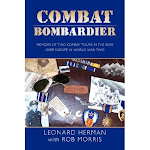 Lyle's mock-up of the cutting device used to connect flattened Klim cans to make metal sheets, table tops, plates and trays. Notched knife is in cut in board. This was used to cut the cans. Seam is visible connecting the two cans. The smaller Spam-type can was used to get solder.
Lyle's mock-up of the cutting device used to connect flattened Klim cans to make metal sheets, table tops, plates and trays. Notched knife is in cut in board. This was used to cut the cans. Seam is visible connecting the two cans. The smaller Spam-type can was used to get solder.The late Basil Lyle Shafer was a B-17 Flying Fortress co-pilot whose 390th BG aircraft was shot down in 1944, killing most of the crew. Lyle ended up in a Luftwaffe prison camp at Barth, Germany. Lyle became a very good friend when I first began writing my book Untold Valor. I had no writing experience, no resume'. I was just a guy who wanted to learn about the men who flew the heavies. Lyle never tired of my sometimes ignorant questions, sending me information on a regular basis for three years. He was the first man I interviewed for the book, and he believed in it from the first. When I got frustrated, he's the guy who kept me going.
Lyle lived near me, just across Teton Pass in Wilson, Wyoming. I visited him there several times. One the second visit, he gave me some of the artifacts he had saved and shown at the POW reunion in Jackson the previous summer. I am going to do a series of articles on some of the ingenious stuff the kriegies came up with. Several of these are from Lyle. The cooking recipes, equally ingenious, are from the late John Chaffin, a 100th BG B-17 pilot who went down on the infamous Munster Mission in October 1943 and became a POW as well.
Lyle made this mock-up to demonstrate how the men in the prison camp made trays, plates, table-tops and other metal items. They used Klim cans, which came in their Red Cross parcels. Lyle explained that they would flatten the cans out, and then cut strips of the cans, which they would make into connecting pieces. They would then slide two flattened Klim cans together by folding the edges of each and sliding them onto the connecting piece. To cut the cans, they used a block of wood and a regular kitchen knife with a notch it it. Lyle said they made everything they needed this way. The photo shows the mock-up Lyle made and gave me some years ago.
Lyle passed away about three years ago. Though he was my #1 believer and backer, he passed away only a few weeks before the book was published and never got to see it.
I will feature more of Lyle's amazing stuff in future posts.
 Lyle Shafer as a young aviation cadet. He was twenty years old when he was shot down.
Lyle Shafer as a young aviation cadet. He was twenty years old when he was shot down. Lyle Shafer's Prisoner of War photo taken at Dalag Luft. He was badly injured when this photo was taken, having lost several teeth, broken his arm, and with a many pieces of flak and shrapnel embedding in his arm. Lyle had bent down to get his flak helmet in the cockpit when a round entered right where his head had been. This round decapitated the pilot and the next split the plane in two.
Lyle Shafer's Prisoner of War photo taken at Dalag Luft. He was badly injured when this photo was taken, having lost several teeth, broken his arm, and with a many pieces of flak and shrapnel embedding in his arm. Lyle had bent down to get his flak helmet in the cockpit when a round entered right where his head had been. This round decapitated the pilot and the next split the plane in two.






1 comment:
I am Lyle'Shafer's oldest daughter, Amy Shafer Gibbs and I live with my husband Robert in Overland Park, KS. I am the mother of his two oldest grandchildren, both girls, Danielle and Hannah.
It warms my heart to see my father remembered in this way. He was the most decent man I ever knew and I miss him greatly. If he had not bent down when he did to get his helmet that day, not only would he not have lived but neither myself or my children would have ever been born. I have thought of how the fateful events of that day shaped not only my family's destiny but also the destiny of the others on his plane and of his fellow POW roommates, many of whom I had the honor of meeting during reunions that my father set up after his retirement. If you care to communicate with me about my father, my email address is amysgibbs@aol.com.
By the way, I have a couple of Klim cans that my dad gave me. And I need to get a copy of your book!
Post a Comment